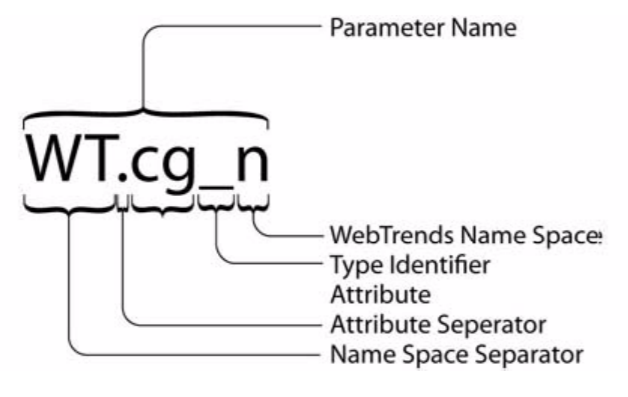Query Parameter Syntax
Webtrends query parameters follow specific syntax that includes name, value, and format. The following sections describe each of these syntax elements.
Name Syntax
The name of each Webtrends query parameter uses the following syntax:

Although Webtrends Analytics handles query parameter names without considering case, JavaScript object names are case-sensitive. Therefore, if you want JavaScript tagging to capture events, you must adhere to specified naming conventions. Webtrends reserved query parameters require an upper case name space, either WT or DCS, and the type identifier in lower case. In addition to the query parameters covered in this chapter, the following name spaces are reserved for Webtrends:
WT.i_
Used for product integrations with Webtrends partners
WT.z_
Used by Webtrends Professional Services for customer integrations
As a best practice, use the following syntax to create custom query parameters:
DCSext.w_custom_identifier
For example, you could create a parameter called DCSext.w_articleid to track an article ID.
Value Syntax
The values associated with Webtrends query parameters use the following syntax:

Each Webtrends query parameter name may have one or more values. Some parameters can be specified in pairs or in groups of related parameters. When related parameters have multiple values, these values may be correlated and their position becomes important as shown in the following example:
WT.si_n=name1;name2&WT.si_x=position1;position2.
In the previous example, if correlation is specified in the report, name1 is associated with position1and name2 with position2.
If there are multiple values, they are typically separated using a semicolon (;). You can use other separators, but you must specify the separator in the dimension or measure setting that is based on the parameter.
Not all Webtrends query parameters support multiple values. For example, HTML Title Page allows only one value.
If the parameter value contains a semicolon, it must be hex-encoded (“%3B”) to differentiate it from the separator.
Numerical Value Format
Unless stated otherwise, numerical values must be specified using the simple US format using the period as the decimal separator with up to 2 decimals and without thousand separators. For example, 12345.67.
Complete Syntax
The Webtrends query parameters are represented as name/value pairs. The name/value pairs adhere to the following syntax:

The Webtrends query parameters are logged in SmartSource Data Collector log files. Each name/value pair is separated by an ampersand (&). The Webtrends query parameters must co-exist with other web site well-known parameters. This means that Webtrends query parameters can be mixed with standard well-known parameters. The Webtrends query parameters can be separated from the other well-known parameters using the ampersand delimiter. While a Webtrends namespace is part of each query parameter, it is conceivable that parameter collisions may occur. If a query parameter string contains duplicate key values, the first instance is used and the others are discarded.
Syntax Examples
Single Parameter With a Single Value
The following example shows a page associated with the “Finance Offer” advertising view:
WT.ad=Finance%20Offer
Single Parameter With Multiple Values
The following example shows a page associated with both the “Finance Offer” and “FishFinder Offer” advertising views:
WT.ad=Finance%20Offer;FishFinder%20Offer
Related Parameters With a Single Value
The following example shows a page associated with the Campaign “New Product” and the Campaign Event Type “click":
WT.mc_id=New%20Product&WT.mc_ev=click
Related Parameters With Multiple Values
The following example shows a page associated with content groups and sub-types. The sub-type “pressre-leases” is associated with the “corporate” content group, while the sub-type“specifications” is associated with the “engineering” content group:
WT.cg_n=corporate;engineering&WT.cg_s=pressreleases;specifications